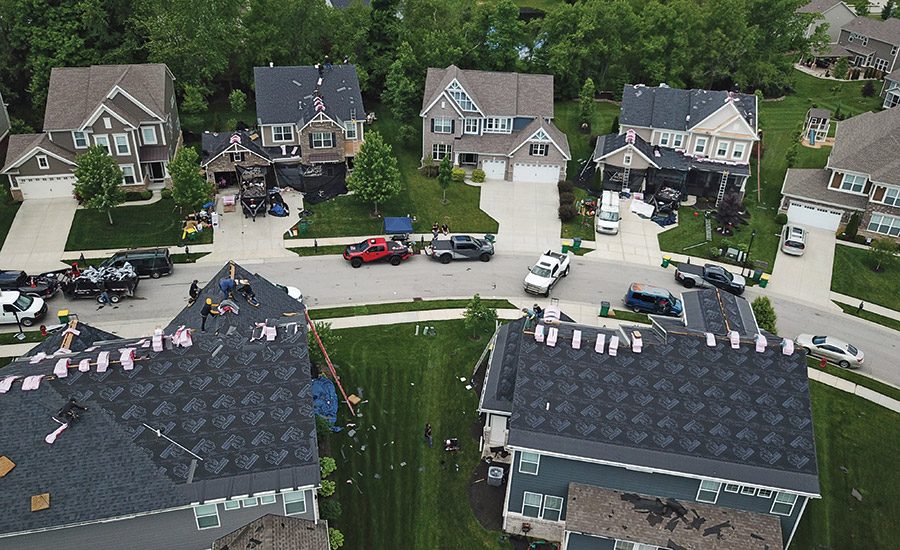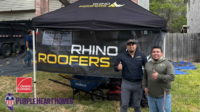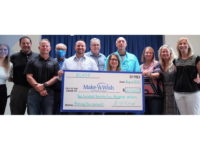Roofing Contractors Are Giving Back and Going Above with Technology During the Pandemic
technology like social media and drones are giving roofing contractors the edge


Drones are one of the best tools roofing contractors can use during the pandemic since they don’t require in-person interactions.


As social distancing efforts have disrupted conventional methods of connecting with customers, roofing contractors are turning to technology to deliver sales presentations, market their business and even give back to their communities. From tapping social media to help homeowners affected by storm damage, to leveraging autonomous drone missions to generate roof scans, contractors are deploying technology to safely sell and serve customers in the wake of the global pandemic.
Giving Back
Generosity and giving back to help others is a hallmark of the roofing community. Tom Kovack, owner of USA Roof Masters — a member of the Owens Corning Roofing Contractor Network in the Philadelphia area — entered the roofing business in 2012. Just a few months later, Superstorm Sandy ravaged the community and Kovack saw how hard times could bring out the best in businesses.
When an entirely different type of storm — COVID-19 — struck in 2020, USA Roof Masters turned to Facebook to give back to those workers on the frontlines of the outbreak. The company offered to provide free roof repairs to any healthcare workers. In just a few weeks, the USA Roof Masters team completed more than 80 repairs free of charge.
A Facebook request for a roofing repair from Charity Hundeyin, in Levittown, Pa., reflects homeowners’ appreciation for the free repairs.
How One Roofer is Using Drones to Grow
Aaron Christy, owner of Indy Roof Company and a member of the Owens Corning Contractor Network in Central Indiana, has been using drone technology to complete inspections for more than a year. He shared how drones are helping homeowners and his business with Owens Corning.
OC: How are you using drones to serve homeowners?
AC: We do a lot of roof inspections with the DJI Mavic Pro drone technology. Homeowners like how quick and easy the process is, but they really love the before and after images we’re able to capture.
OC: What are some benefits drones offer your business?
AC: The drones are an efficient way to handle large projects like homeowner associations or apartment complexes. We can quickly scan a huge number of roofs and pinpoint exactly where the damage is; drone technology really speeds things up.
OC: What are some benefits drones offer beyond worker safety?
AC: Drones are really good at spotting missing shingles and hail damage — any type of impact. More subtle damage — for example, nail lift — still requires walking the roof. But with the introduction of drones, it’s possible to walk the roof less. And it’s the technology that all of the insurance companies are moving toward.
“Thank you for being the hands and feet of goodness in this world, especially at this time,” wrote Hundeyin, who was juggling two nursing jobs as a homecare aide and worker at an adult day care center before the latter closed due to the pandemic.
Hundeyin’s Facebook post requesting a repair shared that her home’s roof was leaking whenever directional rain occurred, causing water to infiltrate at the intersection of her home’s siding and the first level roof. But it turns out, repair simply was not an option.
“The roof simply couldn’t be repaired and there was no choice but to get Charity a new roof,” Kovack said.
The USA Roof Masters team replaced her roof at no charge. Digital tools such as the Build Your Roof digital resource made it possible for Hundeyin to not only select the shingle color options, but learn how the various parts of her roof work together to seal the home from the elements, defend against water and help the home breathe. Hundeyin selected Pacific Wave, the 2020 Owens Corning Shingle Color of the Year, and her new roof was installed in May.
Going Above
While the USA Roof Masters mission was from the heart, other missions literally “rise above” to leverage technology.
Case in point is the use of autonomous drone scans. In a May webinar, Owens Corning teamed up with business partner XAP 360 to share with contractors how an autonomous drone scan can fulfill a few critical missions. First, drones can provide a baseline inspection of a home’s roof to help facilitate timely insurance claims. Drones can also capture a digital image of roof damage after an incident has occurred. Completed in under 10 minutes and conducted with an autonomous drone, the scan provides a granule-by-granule seamless image of the roof, allowing homeowners to see exactly what damage has been inflicted and in what areas.
There are several advantages of partnering with a third-party service to provide drone scans. First, a third-party partner will ensure the contractor receives proper training and is covered with the FAA Small Unmanned Aircraft (Part 107) requirement to operate a drone. And because the technology is completely autonomous, the pressure is off the operator. By pressing a few buttons, the mission can be launched and the report available for review by the homeowner in just minutes.
Beyond operator training, licensing and marketing materials, third-party drone services such as those available through the Owens Corning business partner network, also take care of providing hardware, technology and maintenance coverage.
“Today’s roofers are navigating uncharted waters,” said Mike Schneider, contractor network leader at Owens Corning. “Through technology, roofing contractors are applying their hearts, heads and literally their hands to support our nation.”
Looking for a reprint of this article?
From high-res PDFs to custom plaques, order your copy today!








